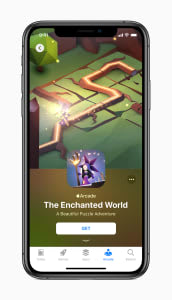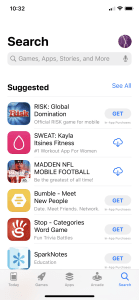On September 10th, 2019, the world was watching as Tim Cook opened Apple’s annual ‘Special Event’. With bated breath, we waited to see what would be announced, which predictions were correct, and ultimately, how any of this might affect our day-to-day life.
The event started by harking back to Apple’s core philosophy, “Give people wonderful tools and they’ll do wonderful things.” Hmm, I wonder if this article would count (seeing as though it’s written on a Mac).
Let’s start with a quick recap of the major announcements affecting App Store Optimization (ASO).
- iOS 13 The new OS is launching on September 19th.
- Apple Arcade The much awaited Apple Arcade game subscription service is launching on September 19th too.
- Apple TV+ All device purchases will come with a 1-year free trial of the new streaming service.
- iPad The new seventh generation model was announced but otherwise rather minor updates from the previous model.
- New Apple Watch Several new upgrades were announced, most interest being that of Watch OS 6 and with it the new watch-only app store and it’s corresponding app discovery method.
- New iPhones Notably 11, 11 Pro and 11 Pro Max, which is the first time language like ‘Pro’ has been incorporated. We suspect in an attempt to further segment the market with a wider price range.
Most of these announcements have very little impact on our work within ASO, except for iOS 13 (albeit slightly minor effects) and the Apple Arcade which will change user behavior from the outset, particularly amongst high-quality gamers.
Let’s start with the biggie, the introduction of Apple Arcade
Apple seems to be going all-in on services. With stagnating device sales, Apple is focussed on alternative revenue streams; Apple TV+, Apple Card, Apple Music, Apple News, and now, Apple Arcade, a subscription service for games.

Instead of the updates tab in the bottom right corner, you’ll find the Apple Arcade tab containing around 100 premium games to begin with.
Against all analyst predictions for a price range of $10-$15 a month, Apple surprised the industry by launching the service at just $4.99/month, making it extremely accessible and able to compete with the cost for in-app purchases of many games.
With such great value for money, we believe Apple Arcade will have more influence than predicted on the way mobile gamers discover and find new games. It’s reach will be greater than simply the relatively small paid mobile game market, mainly in the audience it attracts and the discoverability (and likelihood of install) for free and paid games that are not part of the Apple Arcade.
Traditional freemium game players might be swayed to subscribe
Apple revealed that there are 500 million weekly active users (WAU) visiting the store. Add to that Sensor Tower’s data that the App Store generated 14.8 billion installs in the first half of 2019 (or about 569 million installs per week) and you can easily calculate that on average a single WAU is generating 1.14 installs.
For comparison, let’s take a look at the growth trajectories of other apple services.
- Apple Music grew to 10 million subscribers after six weeks, and then 20 million users after 18 months.
- Analysts expect TV+ to grow to 12 million paid subscribers by the end of 2020.
With a predicted price point of $13/month, HSBC analysts expected Apple Arcade to generate $370M in 2020 (around 2.4 million subscribers). They also expected that to grow to 29 million subscribers within five years. Given that the subscription is almost a third of that estimation, one can expect these numbers to change significantly. The lower price should result in close to double the number of subscribers with 5 million now predicted for 2020. This number also looks reasonable when comparing it to the other services, as gaming is less prevalent and popular an activity than listening to music or watching TV.
So at 5 million subscribers, we’re talking 1% of the App Store WAUs. Even if this means that these users will never install a free game again (which probably isn’t true), it won’t move the needle on overall installs that the rest of the App Store gets.
That being said, these 5 million users are like to represent high-quality gamers, and if over time that number will grow to 30+ million users as the estimates indicate, it could have significant implications for revenues. As high quality (and high spending) gamers will be pulled towards the Arcade selection.
There they’ll find a growing library of high-quality, in-app purchase-free, ad-free games. They’ll be less inclined to play games any other way, thus affecting their desire to play other free games (unless they just increase their overall playtime significantly which is unlikely). Between the sunk-cost fallacy and the desire to ‘make the most of their purchase’ these gamers will view Arcade games as ‘free’ games too. Just ones with a better experience without in-app purchase promotions or ads.
Their disinterest in freemium games will result in less Browse/Search for these users, lowering the overall install pie for free games.
The Apple App Store still generates 30%-40% of installs through Browse and that will probably grow with the Suggested Apps section in the new search tab (more on that below).
With Apple going big on services, they’ll dedicate a significant amount of featuring and editorial real estate, both in the Today Tab and in the Games Tab, to Apple Arcade games in an attempt to grow its user base. Depending on how aggressive Apple are, this will affect the overall number of featuring opportunities that exist for non-Arcade games. Life will get tougher for both paid and free games, but the knock-on effects will take a while to kick in.
Anything else to take note of with iOS 13?
Let’s put it this way, it’s somewhat uneventful. It’s more significant than iOS 12 but much less impactful than iOS 11.
Dark Mode has now officially hit the iPhone
With iOS 13 users will be able to decide whether they want to go with dark mode or stick to what’s always been (now termed light mode). They’ll also be able to choose to switch between the modes automatically depending on the time of day. For those who opt in for dark mode, the App Store (as a native Apple app) will go dark too with a specific dark mode application within the store. A dark store might potentially affect the legibility and overall look of your app store creatives, but seeing as though you won’t have the option of customizing creatives according to mode and without any data surrounding the number of users who use which mode, you’ll just need to make sure your creatives work for both. From our initial analysis of the App Store in both modes, we haven’t been able to identify any striking examples of illegible creatives in dark mode.
A New Search Page for the App Store
Although it wasn’t announced in the event, within the iOS 13 beta there’s a newly designed search page, with a personalized section to be updated based on search history and other personal factors. It will take up a prominent 90% of the page real estate and includes actual app listings (as opposed to the previous search suggestions). This will have an obvious influence on search behavior, how exactly still remains to be seen.

Logically speaking, having another ‘out’ on the search page will lower the number of people that search for keywords and any installs that come from there will count as Browse.
It will likely have the biggest effect on lower intent users (branded search will be less impacted as they’ll still mainly only be satisfied once they find the specific brand they’re looking for). These are users that are looking to solve a problem or have a specific style of game in mind, they’re more likely yto choose the first ‘best’ option presented to them.
TL;DR? Here are some quick takeaways
- Make sure your creatives look good on both light (normal) and dark modes.
- Start analyzing your app’s growth dependency on the non-branded search and on Browse (especially featuring) and start strategizing for a potential decrease in both as Apple Arcade and the new Search Page start to change dynamics.
Remember, the effects of these changes will not be felt immediately as iOS 13 will be rolled out gradually and the Apple Arcade will take months and years to fully take off, but it’s always good business to stay one step ahead of distribution channel changes.
As always, we will continue to monitor and update on the effect of these changes in the weeks and months to come.















